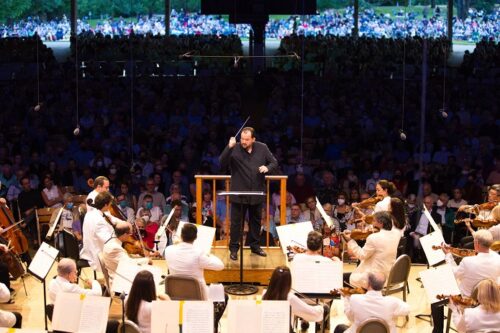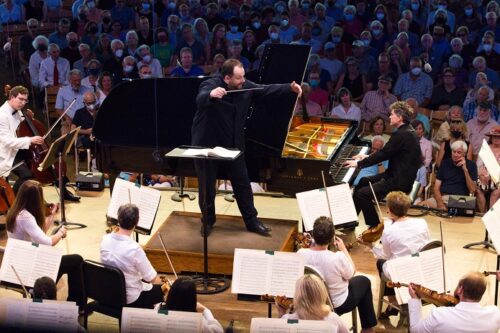 United States Tanglewood 2022 [5]: Paul Lewis (piano), Boston Symphony Orchestra / Andris Nelsons (conductor), Koussevitzky Music Shed, Lenox, (CSa)
United States Tanglewood 2022 [5]: Paul Lewis (piano), Boston Symphony Orchestra / Andris Nelsons (conductor), Koussevitzky Music Shed, Lenox, (CSa)

29.7.2022
Julia Adolphe – Makeshift Castle
Beethoven – Piano Concerto No.2 in B-flat; Piano Concerto No.3 in C minor
30.7.2022
Caroline Shaw – Punctum, for String Orchestra
Beethoven – Piano Concerto No.1 in C; Piano Concerto No.4 in G
31.7.2022
Elizabeth Ogonek – Staring Variations
Farrenc – Symphony No.3 in G minor
Beethoven – Piano Concerto No.5 in E-flat Emperor
One of the highlights of this year’s Tanglewood season was a performance of each of Beethoven’s five piano concertos. They were played over the course of a long, hot weekend by acclaimed British pianist Paul Lewis and the Boston Symphony Orchestra under their principal conductor Andris Nelsons. For Lewis, who celebrated his 50th birthday last May, and who recorded the entire cycle in 2010 for Harmonia Mundi and performed it on numerous occasions since then. Beethoven’s piano works, and in particular these concertos, represent a central part of his repertoire. Completed in a comparatively short time frame, 1798-1809, they chart the composer’s creative journey from the elegant late eighteenth-century classical conventions of Haydn and Mozart to the revolutionary and turbulent musical world of early nineteenth-century Romanticism. Each concerto, unique in itself, imposes immense and increasingly technical and interpretative demands on the pianist. So, hearing them all in short succession gives the listener an unparalleled opportunity not only to reflect on Beethoven’s evolutionary development as a composer, but also to evaluate the craft and artistry of the performer.
Lewis, who has been described as one the world’s greatest exponents of Beethoven’s keyboard works, did not disappoint. At each concert, Lewis’s performance was characterised by intellectual rigour, intelligence, sensitivity, and subtle shifts of colour. These qualities were combined with what can only be described as a dazzling but unflamboyant technique. Apart from the odd flourish of the right hand on the completion of a musical phrase, Lewis’s only physical response to the music was mirrored on his face – his brow furrowed and eyes closed during moments of intense concentration, or a raised eyebrow and a smiling glance towards the conductor after a particularly playful passage. Nelsons, for his part, coaxed and shaped the orchestra’s finely balanced response, eliciting exceptional playing from every section.
The first half of Friday night’s concert centred on Beethoven’s Concerto No.2 in B-flat, whose origins and publication preceded his Concerto No.1 in C by some five years. The B-flat Concerto was premiered in Vienna in 1795, when the composer was only 25 years old. Although Beethoven did not regard it as one of his best works, Lewis captured its youth and energy, giving an elegant rendition, reminiscent of his mentor and former teacher Alfred Brendel. The Mozartian first movement, marked Allegro con brio, was played with the utmost delicacy, and included a beautifully executed cadenza written by Beethoven in 1809. Lewis gave a most tender and free-flowing reading of the lyrical Adagio, moving seamlessly to the third movement and a dramatic change of mood, a fast-moving and playful Rondo, which provided Lewis free rein to demonstrate his supreme virtuosity and impish sense of humour.
The second half featured Concerto No. 3 in C minor, completed and showcased with Beethoven at the keyboard in Vienna in 1803. While Mozart’s long shadow still hovers over the piece, Beethoven’s distinct voice has by this time emerged more clearly. After a dark, march-like, orchestral introduction in which the steady drum-beat of Napoleonic war can be heard, Lewis made a powerful and passionate entry, alternating exquisitely with the orchestra, before launching with unerring accuracy into a Beethoven cadenza of astonishing complexity. Ending in a storm of notes, the first movement gives way to an Adagio which, in the words of Beethoven’s student Carl Czerny, ‘must sound like a holy, distant and celestial harmony’. In Lewis’s hands, the opening melody was simply heart-rending, providing a few moments for private reverie, before the unbridled merriment and exultant laughter of the final Rondo.

Saturday night offered Piano Concertos No.1 in C, and No.4 in G, which were performed by Lewis with exceptional beauty and dexterity. Lewis switched effortlessly between majesty and whimsy in the first concerto’s opening Allegro con brio and gave us a dreamily contemplative Andante. The final Rondo, a scampering, helter-skelter ride of pianistic brilliance, was flawlessly delivered. After the interval came Concerto No.4. Lewis has spoken on a number of occasions of the fragility and elusiveness of this concerto, which of the five is also his favourite. He describes it as a ‘dark canvas onto which is projected a small but slowly expanding beam of light – a door through which the player enters’. Played by Beethoven for the first time at a four-hour public concert in 1808, the original programme also saw the premieres of his Fifth and Sixth Symphonies. The length of the event certainly testifies to the remarkable cultural appetite of Viennese audiences of the day, but more importantly, the inclusion of two of his greatest works indicates the extent of Beethoven’s musical and stylistic evolution within a comparatively short time frame. The Fourth Piano Concerto is yet another manifestation of Beethoven’s genius. From the first tentative chords of the Allegro moderato (replete with the pianist’s own cadenza) to the aching vulnerability of the slow movement, to the ebullience of the finale, Lewis’s mastery was awe-inspiring.
Piano Concerto No.5 in E, the Emperor, crowned Sunday afternoon’s concert. Lewis’s heroic opening flourishes contrasted dramatically with the hymn-like Andante, which he played with such deep intensity that even the birds nesting high up in the Shed’s rafters appeared to fall silent. The final Rondo was nothing less than a triumphant dance whose closing bars drew rapturous applause from a standing audience.
These concerts also included the premieres of contemporary works by three American composers, and all had been recently commissioned by the BSO. The first, Makeshift Castle by Julia Adolphe, commenced Friday night’s concert. The piece, Adolphe explained, explored ‘contrasting states of permanence and ephemerality, of perseverance and disintegration, of determination and surrender’. Subtle orchestration was used to conjure up a constantly changing, eerily bleak and disquieting musical landscape. Adolphe confronted the audience with a dystopian vision of a post-Covid, war-torn and globally warmed planet in which mankind’s survival could no longer be assumed. This was a far cry from the optimism of the Enlightenment, and Beethoven’s immutable belief that through music, the human spirit can surmount any obstacle. This was the reason perhaps, for presenting these diametrically opposed works in the same programme.
The second piece, Punctum by Caroline Shaw, prefaced Saturday night’s concert. Scored for strings, the composition was, as she put it, ‘an exercise in nostalgia’. Inspired by Bach’s St Matthew Passion (the great opening choral was actually referenced), Shaw also drew on Elgar with unmistakable hints of his Introduction and Allegro, Vaughan Williams, and even Tippett, to evoke a pastoral, idealised and very English musical landscape.
‘Looking up at the sky’ was the central theme of Elizabeth Ogonek’s Starling Variations, which marked the first half of Sunday afternoon’s concert. The piece – a set of five humorous variations – uses a bright palette of musical shifting patterns of sound and evocative orchestration to depict the different flight patterns or murmurations of birds as they move in one large mass across the sky.
Starling Variations was swiftly followed by a rarely heard work by a little known French female composer, Louise Farrenc. Her Symphony No.3 in G minor, another first for the BSO, proved to be potpourri of short-lived themes spread over four traditional movements. Composed in 1847, Farrenc was clearly influenced by a number of mid-nineteenth century composers, most noticeably Felix Mendelssohn, who died in the year this symphony was written, and whose ghost haunts the piece. The symphony is well constructed and easy on the ear, but Farrenc had yet to find her own voice. Hardly surprising, since women could study piano performance at the Paris Conservatoire, as Farrenc did, but were not yet permitted to study composition on a formal basis. Private lessons doubtless helped her to overcome some of the many obstacles that then lay in the path of women composers in Europe. One wonders what Farrenc might have been capable of writing had she been afforded the same freedoms and privileges as her male counterparts.
Chris Sallon

Magnificent rendition of Beethoven’s Emperor Concerto by Paul Lewis on Sunday afternoon’s concert!